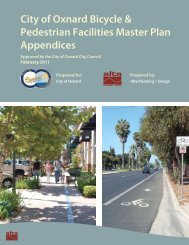Santa Clara River Trail Final Master Plan - Development Services ...
Santa Clara River Trail Final Master Plan - Development Services ...
Santa Clara River Trail Final Master Plan - Development Services ...
Create successful ePaper yourself
Turn your PDF publications into a flip-book with our unique Google optimized e-Paper software.
Chapter 6: Design Guidelines, Maintenance Schedules and Best Practices<br />
Figure 23. Inlaid bronze medallion.<br />
Figure 24.<br />
Mojave <strong>River</strong>walk mile markings stamped in concrete with<br />
cast iron trail medallion inset.<br />
Directional Signs<br />
Directional signs are used on the trail and provide orientation to the trail user and emphasize trail<br />
continuity. At a minimum, street names should be called out at all trail intersections with roadways.<br />
Directional signage should identify key destinations along the trail route and include schools, parks,<br />
municipal centres, trails, and other points of interest.<br />
Wayfinding Signs<br />
Wayfinding signs are used in nearby neighbourhoods and roadways to<br />
provide guidance to the community trying to access the trail. At a<br />
minimum, wayfinding signs should be placed ¼ - ½ mile from nearest<br />
trail access points. Wayfinding signs should identify access points by<br />
landmark or nearest intersection.<br />
<strong>Trail</strong> Etiquette Signs<br />
Establishing goals and policies sets a common framework for<br />
understanding trail rules and regulations. Rights and responsibilities of<br />
trail usage should be stated at gateways. Once rules and regulations are<br />
established, the trail managing agency has a means of enforcement.<br />
Local ordinances may be adopted to help enforce trail policies. Penalties<br />
such as fines or community service may be imposed in response to noncompliance.<br />
Interpretive Signs<br />
Figure 25. Etiquette sign from<br />
the Fanno Creek <strong>Trail</strong>.<br />
Interpretive signage provides enrichment to the trail user experience, focuses attention on the unique<br />
attributes of the local community, and provides educational opportunities. Educating trail users can help<br />
foster trail stewardship by providing a venue to explain the “why” behind some trail rules. For example,<br />
providing information about the fragile riparian habitat and species it supports helps trail users<br />
understand why they should stay on the trail and out of the riverbed.<br />
Interpretive signs should only be located at key locations near gateway entrances and high use areas. The<br />
<strong>Santa</strong> <strong>Clara</strong> <strong>River</strong> corridor is ripe with opportunities for ecological, cultural and historical interpretation.<br />
86 | Alta <strong>Plan</strong>ning + Design
















